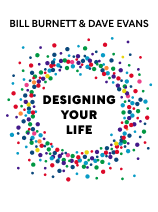

This article is an excerpt from the Shortform book guide to "Designing Your Life" by Bill Burnett and Dave Evans. Shortform has the world's best summaries and analyses of books you should be reading.
Like this article? Sign up for a free trial here .
What difference would it make if you applied design thinking to your life? How do you build a designed life?
A core principle of design thinking is that you make progress by building, not just by thinking. Design thinking requires five mental attitudes: curiosity, experimentation, reframing, embracing process, and deep teamwork. When you apply these to your life, you get back more than you put in.
Read more to learn how to build a designed life.
Living a Designed Life
Everyone wants to make a living doing meaningful work that harmonizes with their values and makes them happy. But many people feel stuck in the wrong life doing unfulfilling work with no way out. Some hope that if only they can find their “true passion,” everything will magically fall into place. Both attitudes—the defeated one and the magical passion one—are false. What we need is a clear-cut process for designing our lives, a learnable approach to building a fulfilling career.
Designing Your Life by Bill Burnett and Dave Evans provides that process. This is a book about life design. Everything surrounding you, from furniture and electronics to indoor plumbing and toothbrushes, was designed. People created each of these things in response to a problem. Just like you can see the benefits of design thinking all around you, you can reap the benefits of such thinking by applying it to your life—building a designed life to create more meaning and joy.
Design Problems vs. Engineering Problems
Design problems are distinct from engineering problems. Engineering problems focus on achieving a clear goal, such as creating hinges for laptop computers that will last for years. By contrast, design problems have no predetermined goal. They simply seek to address a problem in some effective way.
The ultimate design problem may be the realm of aesthetics. For example, the different appearances of a Porsche and a Ferrari represent two different design approaches to solving the “problem” of creating a beautiful car. The central concern of aesthetics is human emotions, and design thinking is the best tool for effectively addressing this. Likewise, finding happiness and fulfillment in life represents an aesthetic/emotional problem, not one with a concrete goal that you know in advance. Thus, for creating a successful, productive life, design thinking—not engineering thinking—is the best approach.
Design Thinking
Building a designed life requires thinking like a designer. A core principle of design thinking is that you make progress by building, not by pure thought. Designers build and test prototypes.
There are five basic mental attitudes in design thinking:
- Curiosity: Be curious. Explore.
- Experimentation: Try things out. Get off the bench and in the game. Welcome change, and don’t get attached to any particular outcome.
- Reframing: Get a different perspective on problems. Reframe wrong, false, and dysfunctional beliefs by recognizing your biases.
- Embracing process: Recognize that you’re on a journey. Enjoy creating multiple prototypes. Enjoy the process instead of focusing on some hypothetical end goal.
- Deep Teamwork: Recognize that design is a fundamentally collaborative activity, unlike a solitary artist creating her work.
When you apply these to your life, you’ll increase your luck. Opportunities start arising on their own. You hear about jobs and meet people in strangely serendipitous ways. Yes, you put in hard work, but the return on your investment of time and effort is disproportionately large. In other words, you get back more than you put in.
More About Deep Teamwork
To fully benefit from life design, you need to gather a “design team,” a group of people who will learn this process and do the exercises with you. Bringing together different people’s knowledge and perspectives can generate more solutions for everybody than any one person could generate on their own.
Passion and Coherence
The design approach to life rejects the popular notion that everything will work itself out if you just “find your passion.” Many people can’t even say what their passion might be. Nor is it true that most people have a single dominant passion. In fact, passion is something that you develop by trying things out, not something that you know ahead of time. Passion isn’t the cause but the result of intelligent life design. Using the design approach to prototype possible lives for yourself will lead you to the work you love.
The bottom line for what constitutes a designed life is this: It makes sense. All of its parts—even (and sometimes especially) its failures—cohere and give meaning to each other. At any point, you’re able to accurately answer the question, “How’s it going?”
A Designed Life—for Good
You can build a designed life by understanding where you are, building a compass (your work and life philosophies) to guide you, wayfinding in your life, generating ideas, prototyping your future, approaching the job market intelligently, embracing productive failure, and creating a life designing team.
From here on out, as you use your new skills to continually design the rest of your life, remember to apply the five design attitudes whenever you encounter situations that call for them. This will bring a continuous flow of information for you to incorporate into your design activities.
- Be curious. Ask how things work and why people do what they do.
- Experiment. Figure out what you want to know more about, and create ways to learn it and try it out.
- Reframe your troubles. Become aware of your perspective, and consider what others there might be.
- Embrace process. Understand the steps involved in whatever you’re doing. Keep track of your questions. Enjoy the journey.
- Practice deep teamwork. Create your team and cultivate a community. Ask for help when you need it.
Also remember to refer frequently to your life compass to assess how things are going: Are you remaining true to yourself? Is your life remaining coherent?
Finally, commit fully to a practice for tuning into non-cognitive forms of knowing. Whether it’s journaling, meditation, tai chi, or another, the discipline of engaging regularly with one or more of these practices will help keep you centered and in touch with your whole being. You’ll have a clearer mind and spirit as you design a joyful and fulfilling life.
Defective belief: After I’ve designed my life, everything will be wonderful.
- Corrected belief: Life design never ends. It’s a joyful lifelong project.
Building a designed life is a lifelong commitment that reaps lifelong rewards.

———End of Preview———
Like what you just read? Read the rest of the world's best book summary and analysis of Bill Burnett and Dave Evans's "Designing Your Life" at Shortform .
Here's what you'll find in our full Designing Your Life summary :
- Why finding your "true passion" in life is a myth
- The five mental attitudes in design thinking
- How to design a meaningful life in which you can truly thrive






